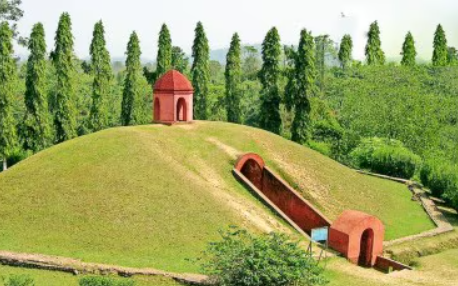Assam’s Charaideo Moidams Added to UNESCO World Heritage List
The Charaideo Moidams in Assam, which are royal burial grounds from the Ahom dynasty, were recently named UNESCO World Heritage Sites. This gives this nationally important area, which is about 30 km from Sivasagar in eastern Assam, international recognition.
What are Moidams?
Moidams are tumuli, which are earth mounds built over the graves of Ahom kings. The moidams of the Ahom royal family are in Charaideo, but you can find other buildings like them all over eastern Assam. Each moidam usually has a vault with rooms inside, a hemispherical mound on top, and a tower called the chow chali that is surrounded by an eight-sided wall. The Ahoms, who were related to the Tai people, chose burial over burning, which is different from Hindu customs. Their unique burial rituals, which were based on old Egyptian practices, meant that these moidams often held more than just the dead. They also held things for the afterlife, servants, animals, and even wives.
The Importance of Charaideo
Charaideo, whose name comes from Tai Ahom words that mean “shining town on a hill,” was the first capital of the Ahom kingdom, which was set up by King Sukaphaa in 1253 AD. It stayed an important power center and is still a place with a lot of historical and cultural value.
Tourism and Preservation
The moidams are popular with tourists today, but many of them are in bad shape. The Archaeological Survey of India only protects 30 of the over 150 moidams. People know that the Charaideo Moidams are important as a whole, especially since they are different from other similar grave sites in terms of size and number of people buried there. Assam’s culture will always be linked to the Ahom kingdom, which ruled for a long time from 1228 to 1826 AD. People praise them for how well they run their government and how strong their military is, especially when fighting off foreign attacks. Celebrating people like Lachit Borphukan at events shows how important they are to modern Indian culture, especially as nationalism grows.
Month: Current Affairs - July, 2024
Category: Art & Culture Current Affairs


